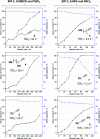Parts-Per-Million of Soluble Pd0 Catalyze the Semi-Hydrogenation Reaction of Alkynes to Alkenes
- PMID: 35584367
- PMCID: PMC9830639
- DOI: 10.1021/acs.joc.2c00616
Parts-Per-Million of Soluble Pd0 Catalyze the Semi-Hydrogenation Reaction of Alkynes to Alkenes
Abstract
The synthesis of cis-alkenes is industrially carried out by selective semi-hydrogenation of alkynes with complex Pd catalysts, which include the Lindlar catalyst (PdPb on CaCO3) and c-Pd/TiS (colloidal ligand-protected Pd nanoparticles), among others. Here, we show that Pd0 atoms are generated from primary Pd salts (PdCl2, PdSO4, Pd(OH)2, PdO) with H2 in alcohol solutions, independently of the alkyne, to catalyze the semi-hydrogenation reaction with extraordinarily high efficiency (up to 735 s-1), yield (up to 99%), and selectivity (up to 99%). The easy-to-prepare Pd0 species hold other potential catalytic applications.
Conflict of interest statement
The authors declare no competing financial interest.
Figures






References
-
- Bonrath W.; Medlock J.; Schütz J.; Wüstenberg B.; Netscher T. Hydrogenation in the Vitamins and Fine Chemicals Industry—An Overview. Hydrogenation 2012, 69–90. 10.5772/48751. - DOI
-
- Howse P. E.; Jones O. T.; Stevens I. D. R.. Synthesis of Pheromones. In Insect Pheromones and their Use in Pest Management; Springer Science & Business Media, 1998; pp 226–245.
-
- Parker G. L.; Smith L. K.; Baxendale I. R. Development of the Industrial Synthesis of Vitamin A. Tetrahedron 2016, 72, 1645–1652. 10.1016/j.tet.2016.02.029. - DOI
-
- Swamy K. C. K.; Reddy A. S.; Sandeep K.; Kalyani A. Advances in Chemoselective and/or Stereoselective Semihydrogenation of Alkynes. Tetrahedron Lett. 2018, 59, 419–429. 10.1016/j.tetlet.2017.12.057. - DOI
-
- Vilé G.; Albani D.; Almora-Barrios N.; López N.; Pérez-Ramírez J. Advances in the Design of Nanostructured Catalysts for Selective Hydrogenation. ChemCatChem 2016, 8, 21–33. 10.1002/cctc.201501269. - DOI
LinkOut - more resources
Full Text Sources

